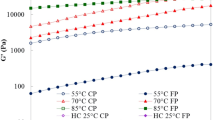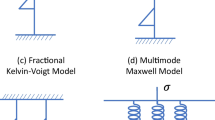Abstract
We describe an improved damage function model for bread dough rheology. The model has relatively few parameters, all of which can easily be found from simple experiments as discussed in this paper. Small deformations in the linear region are described by a gel-like power-law memory function. Then, we consider a set of large non-reversing deformations—stress relaxation after a step of shear, steady shearing and elongation beginning from rest and biaxial stretching. With the introduction of a revised strain measure which includes a Mooney–Rivlin term, all of these motions can be well described by the damage function described previously. For reversing step strains, larger amplitude oscillatory shearing and recoil we present a discussion which shows how the damage function model can be applied in these cases.


















Similar content being viewed by others
References
Abramowitz M, Stegun IA (1965) Handbook of mathematical functions. Dover, New York
Amirkaveei S, Dai SC, Newberry M, Qi F, Shahedi M, Tanner RI (2009) A comparison of the rheology of four wheat flour doughs via a damage function model. Appl Rheol 19:3 Art. 34305
Bloksma AH (1990) Dough structure, dough rheology, and baking quality. Cereal Foods World 35:237–244
Charalambides MN, Wanigasooriya L, Williams JG, Chakrabarti S (2002a) Biaxial deformation of dough using the bubble inflation technique, I. Experimental. Rheol Acta 41:532–540
Charalambides MN, Wanigasooriya L, Williams JG (2002b) Biaxial deformation of dough using the bubble inflation technique, II. Numerical modelling. Rheol Acta 41:541–545
Gabriele D, de Cindio B, D’Antona P (2001) A weak gel model for foods. Rheol Acta 40:120–127
Hibberd GE, Wallace WJ (1966) Dynamic viscoelastic behaviour of wheat flour doughs. Rheol Acta 5:193–198
Kitoko V, Keentok M, Tanner RI (2003) Study of shear and elongational flow of solidifying polypropylene melt for low deformation rates. Korea-Australia Rheology J 15:63–73
Leroy V, Pitura KM, Scanlon MG, Page JH (2010) The complex shear modulus of dough over a wide frequency range. J Non-Newton Fluid Mech 165:475–478
Lodge AS (1964) Elastic liquids. Academic, London
Ng TSK, McKinley GH (2008) Power law gels at finite strains. The nonlinear rheology of gluten gels. J Rheol 52:417-449
Phan-Thien N, Newberry M, Tanner RI (2000) Non-linear flow of a soft solid-like viscoelastic material. J Non-Newton Fluid Mech 92:67–80
Pipkin AC (1986) Lectures on viscoelasticity theory, 2nd edn. Springer, New York
Schofield RK, Scott Blair GW (1932) The relationship between viscosity, elasticity and plastic strength of soft materials as illustrated by some mechanical properties of flour doughs, I. Proc R Soc Lond A138:707–719
Schofield RK, Scott Blair GW (1933a) The relationship between viscosity, elasticity and plastic strength of soft materials as illustrated by some mechanical properties of flour doughs, II. Proc R Soc Lond A139:557–566
Schofield RK, Scott Blair GW (1933b) The relationship between viscosity, elasticity and plastic strength of soft materials as illustrated by some mechanical properties of flour doughs, III. Proc R S Lond A141:72–85
Schofield RK, Scott Blair GW (1937) The relationship between viscosity, elasticity and plastic strength of soft materials as illustrated by some mechanical properties of flour doughs, IV. Proc R Soc Lond A160:87–94
Tanner RI (2000) Engineering rheology, 2nd edn. Oxford University Press, Oxford
Tanner RI, Tanner E (2003) Heinrich Hencky: a rheological pioneer. Rheol Acta 42:93–101
Tanner RI, Dai SC, Qi F (2007) Bread dough rheology and recoil 2. Recoil and relaxation. J Non-Newton Fluid Mech 143:107–119
Tanner RI, Qi F, Dai SC (2008a) Bread dough rheology and recoil 1. Rheology. J Non-Newton Fluid Mech 148:33–40
Tanner RI, Dai SC, Qi F (2008b) Bread dough rheology in biaxial and step-shear deformation. Rheol Acta 47:739–749
Wang C, Dai SC, Tanner RI (2006) On the compressibility of bread dough. Korea-Australia Rheology J 18:127–131
Winter HH, Mours M (1997) Rheology of polymers near liquid-solid transitions. In: Neutron spin echo spectroscopy, viscoelasticity, rheology. Advances in Polymer Science, vol 134. Springer, Berlin/Heidelberg, pp 165–234
Acknowledgements
We are grateful to the Australian Research Council for financial support via grants DP0771339 and DP1095097.
Author information
Authors and Affiliations
Corresponding author
Appendices
Appendix A: Strain measures used
In the concept of strain, one needs to define a reference geometry and another, the new (or strained) geometry. The deformation of the body in moving from the reference state to the new state leads to the development of the three strain forms used here (C, C − 1 and the Hencky strain ε H ). The necessary derivations for general flows can be found in Tanner (2000) and in other texts; here, we give needed results only.
The tensor C(t ′) and its inverse, C − 1(t ′), termed the Finger strain tensor, will be used here; it was explained by Lodge (1964) that C − 1 is of major importance in describing the mechanics of rubbery materials. These tensors use the current configuration x(t) as the reference state; the location of a particle that is at x at time t, is denoted by r at time t ′, as assumed in Eqs. 3 and 4 above. Examples of the calculation of C and C − 1 for shear are given in Eqs. 5 and 6 above. For elongation along the x-axis, lengths along the x-direction in the strained state are λ times the lengths in the reference state. Because of incompressibility, the y and z coordinates shrink by a factor \(1/\sqrt \lambda\). Hence
Hence, the F tensor is diagonal, with entries λ, \(1/\sqrt \lambda\), \(1/\sqrt \lambda\) for the diagonal elements, (and zero for the off-diagonal entries), so that
and its inverse is
In the damage function f we use the Hencky strain magnitude ε H as its argument. This strain is calculated from the initial rest state. Let the initial state be described by X (X i in coordinate notation). Then the strain relative to X at time t, (the particle is now at location x) can be written, following the equations discussed above as
where the component F ij is now \(\partial x_{i} / \partial X_{j}\). The Hencky strain tensor H is defined as
We will use the largest principal positive eigenvalue of H as the measure of strain from rest (ε H ). In this Appendix, we will consider elongation and shear in detail.
In elongation, using Eq. 27
Since λ > 1 for elongation, the largest positive eigenvalue of H is ln λ, and hence we use it as a measure of damage ε H , where
Clearly, ln λ is the classical Hencky or logarithmic strain for a stretch λ (Tanner and Tanner 2003). For compression (equivalent to biaxial stretching) λ < 1, so ln λ is negative and the largest positive eigenvalue is now \(-\frac{1}{2}\ln \lambda \).
In shear, the matter is more complex since C is not diagonal. However, the principal values of C are well known to be 1 and \(1+\frac{\gamma ^2}{2}\pm | \gamma |\sqrt {1+\frac{\gamma ^2}{4}}\) (Kitoko et al. 2003). Hence, the largest positive principal strain here defines the Hencky strain in terms of γ as
In more complex deformations, it is generally necessary to find the largest principal strain at each point numerically.
Appendix B: Method of calculation
The value of the integral in Eq. 1 is not always easy to compute accurately, and hence we have devised an alternative method for stress computation which uses only a standard Runge–Kutta routine. The method is limited to those cases where the stress is uniform in the material, so \(\boldsymbol\sigma\) is a function of time, but not of space.
We consider Eq. 1 with a single exponential memory function, so that
We define
and
Then it is well known (Tanner 2000) that Eq. 35, using Eq. 34, is equivalent to
where d is the rate of deformation tensor, defined \(d_{ij} =\frac{1}{2}({\frac{\partial v_i }{\partial x_j }+\frac{\partial v_j }{\partial x_i}})\), and the upper convected derivative Δτ/Δt is given by
where L is the velocity gradient tensor, so \(L_{ij} =\partial v_i /\partial x_j\). For the case when there is no spatial dependence on x, \(({\bf v} \cdot \nabla) \boldsymbol{\tau}_{i}\) is zero, and (B4) is a set of six ordinary differential equations in time for finding \(\boldsymbol{\tau_{i}}\), which may be solved using a standard Runge–Kutta routine.
Similarly, we have for \(\boldsymbol{\tau}_i^\ast\) the lower convected derivative Maxwell model:
which also, for \(({\rm {\bf v}}\cdot \nabla )\boldsymbol{\tau}_i^\ast =0\), gives a set of six ordinary differential equations in time for \(\boldsymbol{\tau}_i^\ast\). This result can be extended to any number of relaxation times λ i (i = 1, 2 ······n) and the sum of \(\boldsymbol{\tau} + a\boldsymbol{\tau}*\) divided by (1 + a) finds the total stresses \((\boldsymbol{\sigma} + P{\bf I})\).
To approximate well the power-law memory function m(t) in Eq. 2 we have used 14 or 16 relaxation times (Tanner et al. 2007). These are evenly spaced logarithmically at 0.5-decade frequency, so the ratio of two successive relaxation times (λi + 1/λ i ) is 3.162 ( ≡ r).
Then from Pipkin (1986), we find
where p is the exponent in Eq. 2 and
Hence, there is no need for more constants—only the p and the G(1) are needed to describe the complete memory function. Table 1 shows typical results for JANZ dough (We have inflated the contribution of the largest relaxation time to allow for the fact that there is no real cutoff of the spectrum).
Having these data, and initial stresses at t = 0 being assumed to be zero, we can solve for the stresses once the behaviour of the L ij (t) components is known (in these spatially homogeneous flows, we are only interested in differences of stress, or in shear stress, so we do not have to find the pressure P). Once the \(\boldsymbol{\tau}_{i}\) and \(\boldsymbol{\tau}_i^\ast\) are found, the total stress can be found by summing over the modes (1, 2 ······n) and multiplying by the damage function f:
For spatially varying flows, further work is needed; one is left to solve sets of first-order partial differential equations.
Rights and permissions
About this article
Cite this article
Tanner, R.I., Qi, F. & Dai, S. Bread dough rheology: an improved damage function model. Rheol Acta 50, 75–86 (2011). https://doi.org/10.1007/s00397-010-0512-3
Received:
Revised:
Accepted:
Published:
Issue Date:
DOI: https://doi.org/10.1007/s00397-010-0512-3




